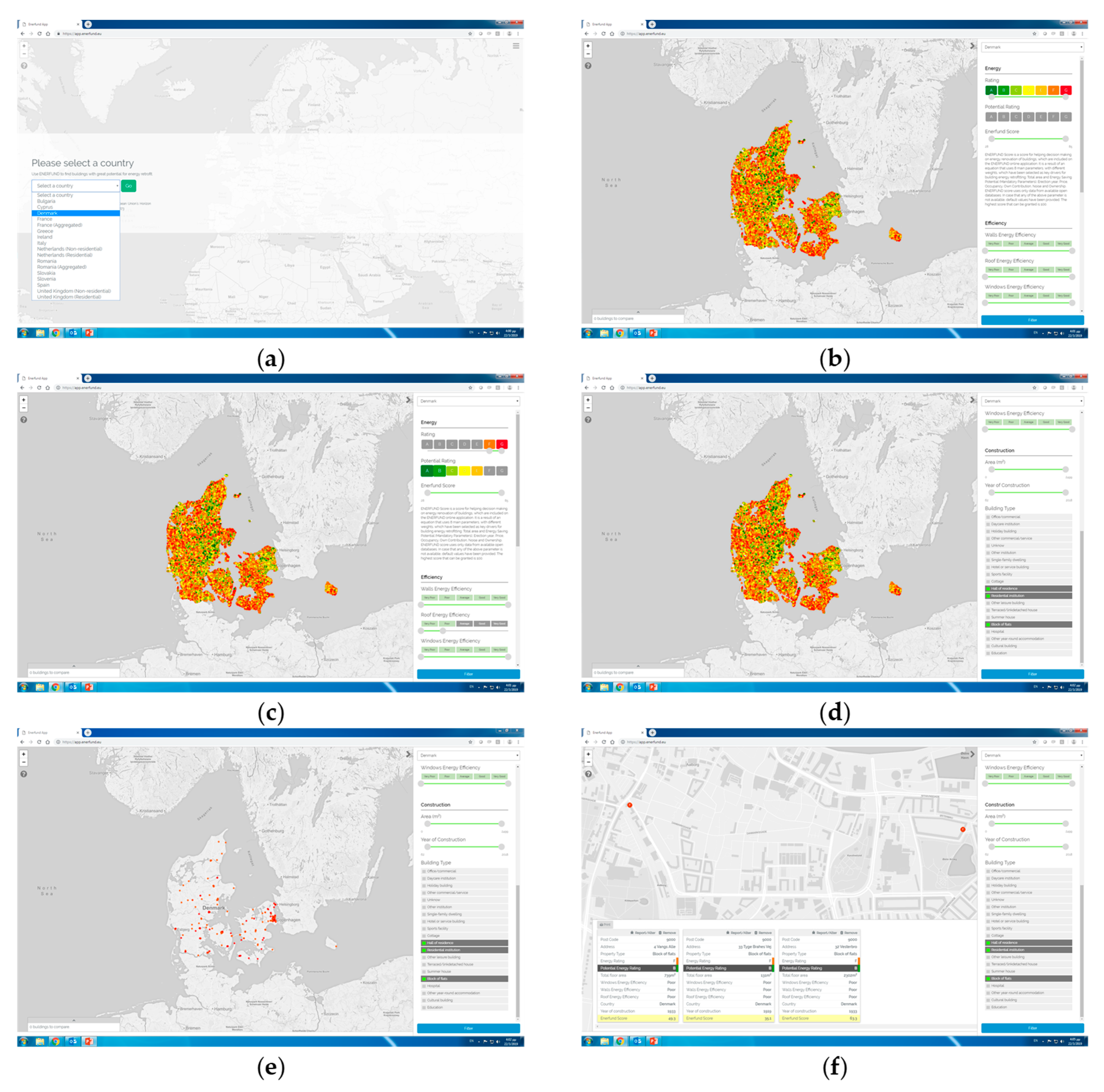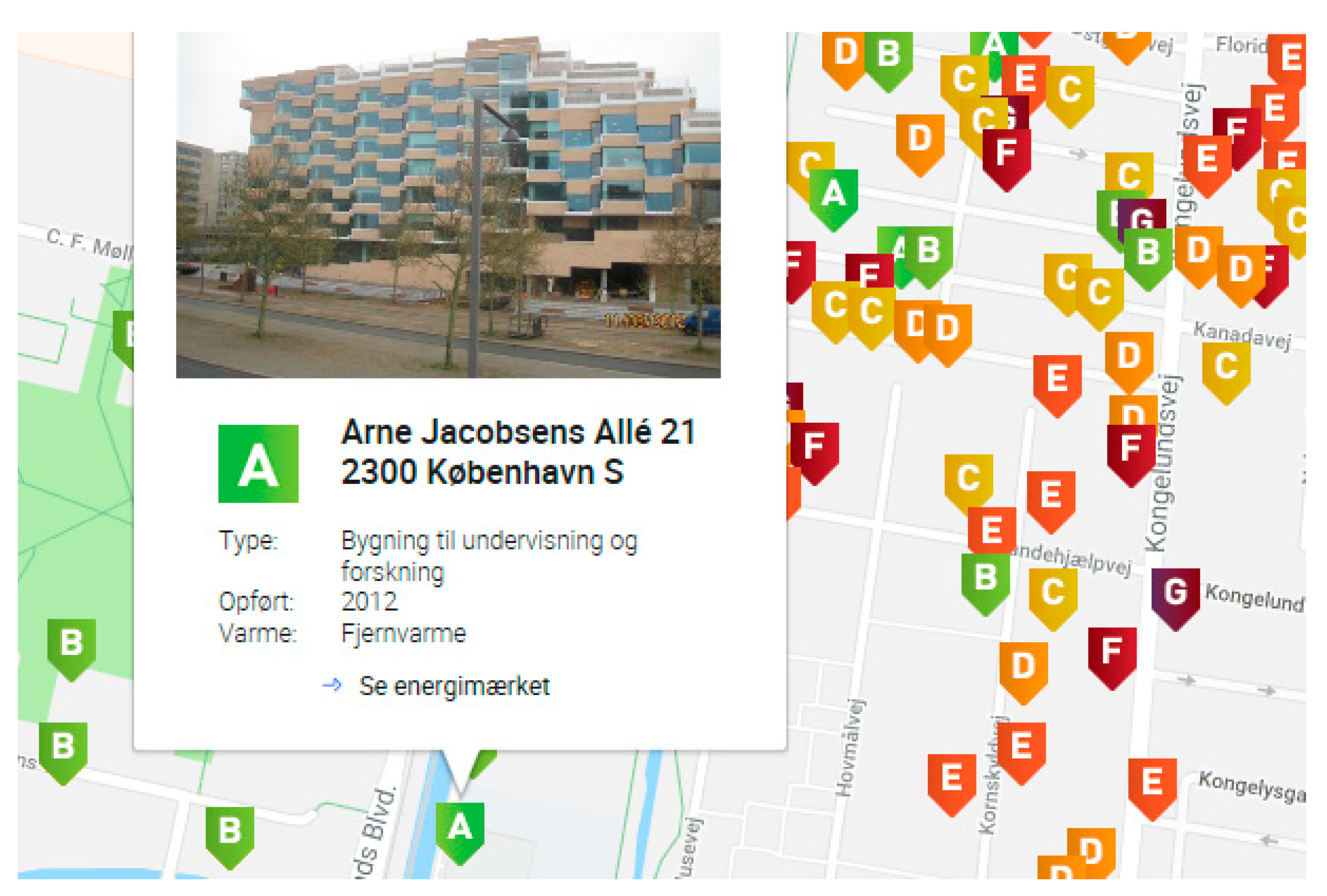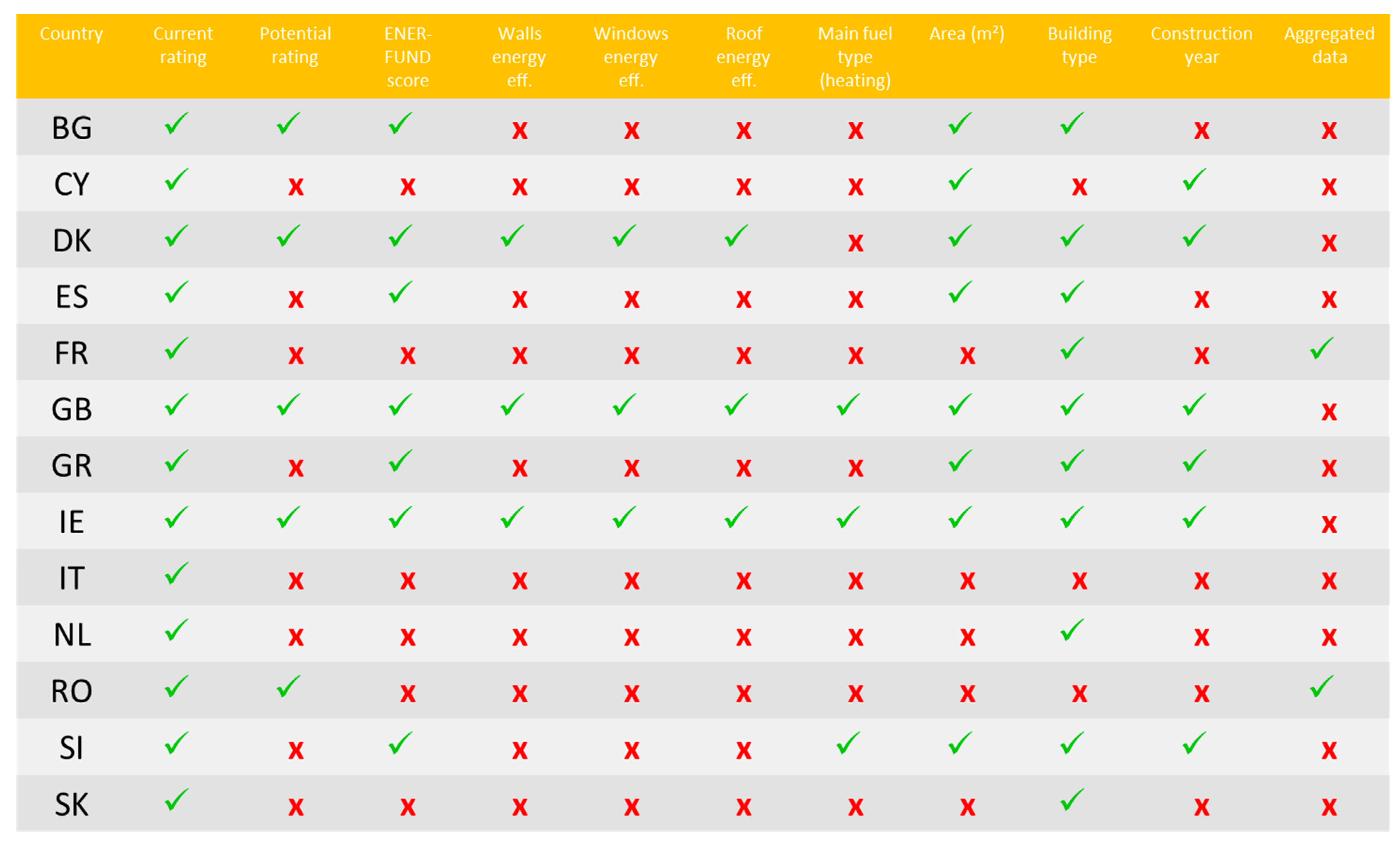Public Access to Building Related Energy Data for Better Decision Making in Implementing Energy Efficiency Strategies: Legal Barriers and Technical Challenges
Abstract
:1. Introduction
1.1. Policy Background and Motivation: Decarbonizing the Building Sector
1.2. Legal Foundation: Transparency of Public Administration and Protection of Personal Rights
1.2.1. Transparency of Public Administration: Access to Environmental Information, Geodata, and Open Governmental Data
- Basic data of real estate or parts of real estate:
- (1)
- Size, location, and address;
- (2)
- Topographical nature;
- (3)
- Building stock, use, and technical facilities;
- Emission and immission values;
- Consumption of energy sources (especially solid fuels, oil, gas, electricity, and district heating).
- They refer to an area in which a member state exercises sovereign powers;
- They are available in electronic form;
- They are in the hands of a public authority, have been drawn up by an authority, are administered by it, are managed by it, are covered by its public contract, are kept for it, or are available to third parties to whom network access is granted;
- And they concern one or more of the topics listed in Annex 1, 2, or 3 of the Directive.
- Geographical names: Names of areas, regions, towns, cities, suburbs, towns, or settlements and any geographical or topographical feature of public or historical interest.
- Administrative units: Local, regional, and national administrative units, which are separated by administrative boundaries.
- Addresses: Localization of properties based on address data, usually street name, house number, and postal code.
- Cadastral parcels: Areas determined by reference to the land register or equivalent directories.
- Building: Geographic location of buildings.
- Energy sources: Energy sources such as hydrocarbons, hydropower, bioenergy, solar, and wind energy, etc., possibly with depth and height information for the expansion of the energy source.
- Completeness;
- Primary sources;
- Temporal proximity;
- Easy access;
- Machine readability;
- Non-discrimination;
- Use of open standards;
- Licensing;
- Durability;
- Usage costs.
1.2.2. Protection of Personal Rights: General Data Protection Regulation (GDPR)
2. The ENERFUND Approach
2.1. Technical Solution Envisaged
- (a)
- From https://app.enerfund.eu/, the user selects the country of interest.
- (b)
- The current EPC rating of all the buildings in the said country in the form of colored dots are now displayed and the user can filter through the menu on the right of the screen.
- (c)
- Using the options in the right menu, the user can choose to display buildings based energy related data (i.e., only show buildings with an EPC rating of F and G).
- (d)
- The user can also choose other parameters, such as type of buildings or construction year.
- (e)
- Once the user presses “Filter”, only the buildings of interest are shown on the map, and the user can zoom in a specific region.
- (f)
- By clicking on the colored dots and expanding the bottom menu, the user can see more detailed data per building.
2.2. Data Source Energy Performance Certificate (EPC)
- The energy labeling, also called energy rating, and some key indicators about the building and its energy performance (such as address, area, climatic data, energy efficiency data in the form of several indicators, date of issue, and details concerning the company or person who issued the EPC);
- An attachment enclosing input-data needed for energy performance calculation and calculation results as such.
2.3. Databases Used for Populating the ENERFUND Tool
2.4. Processing of EPC Data for Display at the European Level
2.5. Results
- Energy indicators included in the EPC differ: There are different specifications of energy indicators depending on the national or regional adaptations of the calculation method and other legal provisions at the member states’ level.
- Geolocation of data: Even though the address (i.e. postcode) of the building is specified in the EPC, the actual location of the building is often not connected to its address, thus external databases and/or methodologies are needed to match postcode to geolocation, resulting in huge delays in mapping the EPCs.
- The level of detail of publicly available EPC data differs: There are various levels of detail regarding publicly accessible geo-referenced EPC data due to the range of interpretation regarding the term “identifiable”, having resulted in different interpretations in member states.
3. Data Protection Rules and Public EPC Data
3.1. Analysis of Legal Barriers Related with Data Protection
3.2. General Data Protection Regulation (GDPR) and Building Related Energy Data
3.2.1. Are EPC Data Personal Data or Non-Personal Data?
3.2.2. Making a Difference: Building Address and Residential Address
- The localization of a person;
- The localization of a moveable item that can be assigned or assigned to a specific person;
- The indication of a place that a particular person regularly uses, in particular inhabited;
- The specification of a locality assigned to a person as the owner under civil law.
3.2.3. Distinguishing Between Processing and Disclosure of Data
- Public accessibility of geo-referenced EPC data: There is no reference to persons within the meaning of the GDPR. If a third person has access to the geo-referenced technical building characteristics, it is theoretically possible to establish a personal reference to buildings by querying the Land Register, since the owners are recorded in the Land Register. However, this is associated with considerable effort, since the queries must be entered individually and a general automated query is not possible without legitimate interest. Each person also has the right to request registration information from the registration authorities about the principal place of residence of another person. The goal of the request, however, is to determine the address of a person and not which persons are registered at an address.
- Data processing by an authority to make the EPC data available in a geo-referenced way: If this is an authority with access to the Central Resident Register, then, according to relative theory, it is possible to establish a personal reference.
3.2.4. Lawfulness of Processing Personal Data and Opening Clauses
- The person concerned gives his/her consent to process personal data for one or more purposes (point a);
- Data processing is necessary to protect vital interests of the persons concerned or other natural persons (point d);
- The processing of personal data is required due to specific factors, such as the performance of a contract, compliance with a legal obligation, the performance of a task carried out in the public interest and in the exercise of official authority vested in the controller, or to protect interests of responsible persons or third parties (point b, c, e, and f).
3.3. Is Energy Efficiency and CO2 Reduction a Task Carried Out in the Public Interest?
4. Discussion
4.1. ENERFUND Tool Provides Public Access of EPC Data to Support EU‘s Climate and Energy Policy
4.2. Public Access of Data to Support EU‘s Climate and Energy Policy Verus Personal Rights Protection
4.3. Building Address Can Be Contextually Assigned as Personal or Non-Personal Data
4.4. Solving the Problem by Referring to the Intention of the Legislator
5. Conclusions
5.1. Clarification of Context: EPC Data As Non-Personal Data
5.2. Data Source: Independent Control System According to Article 18 EPBD
5.3. Method of Presentation: Digital Cadastral Map
Author Contributions
Funding
Conflicts of Interest
References
- Directive (EU) 2018/844 of the European Parliament and of the Council of 30 May 2018 amending Directive 2010/31/EU on the energy performance of buildings and Directive 2012/27/EU on energy efficiency (Text with EEA relevance). Off. J. Eur. Union L 2018, 156, 75.
- Paris Agreement. Off. J. Eur. Union L 2016, 282, 4.
- European Commission. Building the Energy Union. Available online: https://ec.europa.eu/energy/en/topics/energy-strategy-and-energy-union/building-energy-union (accessed on 14 April 2019).
- Directive 2010/31/EU of the European Parliament and of the Council of 19 May 2010 on the energy performance of buildings (recast). Off. J. Eur. Union L 2010, 153, 13–35.
- Council Directive 93/76/EEC of 13 September 1993 to limit carbon dioxide emissions by improving energy efficiency (SAVE). Off. J. Eur. Communities L 1993, 237, 28–30.
- Directive 2002/91/EC of the European Parliament and of the Council of 16 December 2002 on the energy performance of buildings. Off. J. Eur. Communities L 2003, 1, 65.
- Geissler, S.; Altmann, N. CT1 Thematic Report—How to Make the Best Use of EPCs. 2015. Available online: https://www.epbd-ca.eu/wp-content/uploads/2011/05/CA-EPBD-How-to-make-use-of-EPCs.pdf (accessed on 17 April 2019).
- The ENERFUND Project: An ENERgy Retrofit FUNDing Rating Tool. Available online: http://enerfund.eu/ (accessed on 14 April 2019).
- Regulation (EU) 2016/679 of the European Parliament and of the Council of 27 April 2016 on the protection of natural persons with regard to the processing of personal data and on the free movement of such data, and repealing Directive 95/46/EC (General Data Protection Regulation). Off. J. Eur. Union L 2016, 119, 1–88, (Text with EEA relevance).
- Directive 2003/4/EC of the European Parliament and of the Council of 28 January 2003 on public access to environmental information and repealing Council Directive 90/313/EEC. Off. J. Eur. Union L 2003, 41, 26–32.
- Directive 2007/2/EC of the European Parliament and of the Council of 14 March 2007 establishing an Infrastructure for Spatial Information in the European Community (INSPIRE). Off. J. Eur. Union L 2007, 108, 1–14.
- Directive 2003/98/EC of the European Parliament and of the Council of 17 November 2003 on the re-use of public sector information, Official Journal of the European Union L 2003/345, 90 as amended by Directive 2013/37/EU of the European Parliament and of the Council of 26 June 2013 amending Directive 2003/98/EC on the re-use of public sector information (Text with EEA relevance). Off. J. Eur. Union L 2013, 175, 1.
- Council Directive of 7 June 1990 on the freedom of access to information on the environment (90/313/EEC). Off. J. Eur. Communities L 1990, 158, 56–58.
- Gesetz über den Zugang zu Informationen über die Umwelt LGBl für Wien 2001/15 idF LGBl für Wien 2018/62. Wiener Umweltinformationsgesetz—Wr. UIG. Available online: https://www.ris.bka.gv.at/GeltendeFassung.wxe?Abfrage=LrW&Gesetzesnummer=20000201 (accessed on 17 April 2019).
- Wiener Stadtentwicklungs-, Stadtplanungs- und Baugesetzbuch, LGBl für Wien 1930/11 idF LGBl für Wien 2018/37, § 2a Abs 3 Z 1 und 2. Bauordnung für Wien - BO für Wien. Available online: https://www.ris.bka.gv.at/GeltendeFassung.wxe?Abfrage=LrW&Gesetzesnummer=20000006 (accessed on 17 April 2019).
- The Nine Provinces of Austria. Available online: http://www.geoland.at/ (accessed on 14 April 2019).
- Damm, M. Der Zugang zu staatlichen Geodaten als Element der Daseinsvorsorge; Duncker & Humblot: Berlin, Germany, 2017; ISBN 9783428150960. [Google Scholar]
- Klessmann, J.; Denker, P.; Schieferdecker, I.; Schulz, S.E. Open Government Data Deutschland. Eine Studie zu Open Government in Deutschland im Auftrag des Bundesministerium des Innern. 2012. Available online: https://www.verwaltung-innovativ.de/SharedDocs/Publikationen/eGovernment/open_government_data_deutschland_langfassung.pdf?__blob=publicationFile&v=5 (accessed on 29 December 2018).
- Directive 95/46/EC of the European Parliament and of the Council of 24 October 1995 on the protection of individuals with regard to the processing of personal data and on the free movement of such data. Off. J. Eur. Communities L 1995, 281, 31.
- Convention for the Protection of Human Rights and Fundamental Freedoms, Rome, 4.XI.1950. Available online: https://www.echr.coe.int/Documents/Convention_ENG.pdf (accessed on 14 April 2019).
- Charter of Fundamental Rights of the European Union (2012/C 326/02). Off. J. Eur. Union C 2012, 326, 391.
- Thing, § 285 ABGB, § 2297 ABGB, JGS No. 946/1811. Available online: https://www.ris.bka.gv.at/GeltendeFassung.wxe?Abfrage=Bundesnormen&Gesetzesnummer=10001622 (accessed on 14 April 2019).
- Right to privacy, § 1328a ABGB, JGS No. 946/1811. Available online: https://www.ris.bka.gv.at/GeltendeFassung.wxe?Abfrage=Bundesnormen&Gesetzesnummer=10001622 (accessed on 14 April 2019).
- Geissler, S.; Androutsopoulos, A.; Charalambides, A.G.; Jareño Escudero, C.; Jensen, O.M.; Kyriacou, O.; Petran, H. ENERFUND—Identifying and rating deep renovation opportunities. In Proceedings of the Manuscript submitted to SBE Graz Conference, Graz, Austria, 11–14 September 2019. [Google Scholar]
- Geissler, S. Öffentliche Zugänglichkeit von gebäudebezogenen Energiedaten. Master’s Thesis, Donau-Universität, Krems, Austria, 2019. [Google Scholar]
- Article 29 Data Protection Working Party. Opinion 4/2007 on the Concept of Personal Data. 01248/07/EN WP 136. Adopted on 20th June. Available online: https://ec.europa.eu/justice/article-29/documentation/opinion-recommendation/files/2007/wp136_en.pdf (accessed on 15 April 2019).
- Ehmann, E.; Selmayr, M. Einführung. In DS-GVO: Datenschutz-Grundverordnung: Kommentar, 2. Auflage; Ehmann, E., Selmayr, M., Albrecht, J.P., Baumgartner, U., Bertermann, N., Beck, C.H., Eds.; LexisNexis: München, Wien, Gemany, 2018; pp. 91–148. ISBN 978 3 406 72006 2. [Google Scholar]
- Bundesgesetz über das polizeiliche Meldewesen BGBl 1992/9 idF BGBl I 2018/56. Meldegesetz 1991—MeldeG. Available online: https://www.ris.bka.gv.at/GeltendeFassung.wxe?Abfrage=Bundesnormen&Gesetzesnummer=10005799 (accessed on 17 April 2019).
- Pirc Musar, N. Access to Public Information Versus Protection of Personal Data. How to Strike the Right Balance Using A Public Interest Test; NWV: Wien, Austria, 2018; ISBN 978-3-7083-1213-2. [Google Scholar]
- Pignatelli, F.; Martirano, G. INSPIRE Harmonisation of existing Energy Performance Certificate datasets. In European Union Location Framework Energy Pilot; Publications Office: Luxembourg, 2016; ISBN 978-92-79-64461-0. [Google Scholar]
- Statistik Austria. Gebäude und Wohnungen 2011 nach Art des (Wohn-)Gebäudes und politischen Bezirken. Available online: http://www.statistik.at/web_de/statistiken/menschen_und_gesellschaft/wohnen/wohnungs_und_gebaeudebestand/index.html (accessed on 15 April 2019).
- Bundesgesetz vom 3. Juli 1968 über die Landesvermessung und den Grenzkataster BGBl 1968/306 idF BGBl 2016/51. Vermessungsgesetz—VermG. Available online: https://www.ris.bka.gv.at/GeltendeFassung.wxe?Abfrage=Bundesnormen&Gesetzesnummer=10011400 (accessed on 17 April 2019).



| Type of Information | Minimum Contents of the EPC | Optional Contents of EPC |
|---|---|---|
| Parameters of energy efficiency (article 11 paragraph 1) | Overall energy performance of buildings and parameters such as minimum requirements for total energy efficiency to allow owners and tenants of buildings or building units to compare and assess their overall energy performance. | Additional information such as annual energy consumption, percentage of energy from renewable sources in the total energy expenditure. |
| Recommendations for improving energy efficiency (article 11 paragraph 2 and 3) | Recommendations for least-cost or cost-efficient improvement of the energy efficiency of a building or building unit; recommendations must be technically feasible for the specific building concerned. | Estimation of the payback-period or the cost advantages during the operational life span. |
| Reference where to find detailed information (article 11 paragraph 4) | Guideline (indication) where the owner or tenant can obtain more detailed information concerning the cost efficiency of recommendations contained in the EPC; information regarding the steps to be taken to implement these recommendations. | Further information concerning relevant aspects such as energy audits or financial motivators or other possibilities of financing. |
| Country | Database Link (If Available) | Notes |
|---|---|---|
| Austria | N/A | EPC data are not public data in Austria. |
| Bulgaria | N/A | Data export might be given in the form of files. |
| Cyprus | N/A | N/A |
| Denmark | http://sparenergi.dk/forbruger/vaerktoejer/find-dit-energimaerke | EPC data are public data in Denmark. They are available by use of an internet link of Spar Energy. Raw data, geodata included, is required by Netcompany. |
| France | https://www.data.gouv.fr/fr/datasets/base-des-diagnostics-de-performance-energetique-dpe/ | The dataset includes per EPC and for the domestic sector only. For full database http://www.observatoire-dpe.fr/index.php/statistique with statistics easily accessible but aggregated to the departments levels. EPC database is available for Paris municipal buildings. |
| Greece | http://www.ypeka.gr/Default.aspx?tabid=907&language=el-GR | Aggregated data for EPCs for geographical areas, decade of construction, use, energy category, energy consumption, etc. |
| Ireland | https://ndber.seai.ie/BERResearchTool/Register/Register.aspx | Residential data only at the local level, not at the building level Non-residential data on the building level |
| Romania | N/A | Legal responsibility of the central EPC database is under MDRAPFE, while the EPC in electronic format are received and stored by NIRD URBAN-INCERC. The data could be mapped if each EPC is geocoded semi-automatically using the address. |
| Slovakia | http://www.inforeg.sk/ec/SearchEC.aspx | Only in Slovak language. Geo-Data are contained in field “Adresa budovy”, where the text after the last comma represents the name of the municipality. |
| Slovenia | http://www.energetika-portal.si/podrocja/energetika/energetske-izkaznice-stavb/register-energetskih-izkaznic/ | Complete register of EPCs is publicly available in pdf only. Single EPCs can be found on http://prostor3.gov.si/javni. |
| Spain | http://icaen.gencat.cat/es/energia/usos_energia/edificis/certificacio/registre_certificats/ https://www.iderioja.larioja.org/vct/index.php?c=506a6a7670454c724c4772527a366c6c62666d3130673d3d&t=5&e1=A | Only two regions have maps of geo-referenced EPC. |
| United Kingdom | https://epc.opendatacommunities.org/ https://www.ndepcregister.com/ | Access to EPC data for buildings in England and Wales. Non Domestic EPC register. |
© 2019 by the authors. Licensee MDPI, Basel, Switzerland. This article is an open access article distributed under the terms and conditions of the Creative Commons Attribution (CC BY) license (http://creativecommons.org/licenses/by/4.0/).
Share and Cite
Geissler, S.; G. Charalambides, A.; Hanratty, M. Public Access to Building Related Energy Data for Better Decision Making in Implementing Energy Efficiency Strategies: Legal Barriers and Technical Challenges. Energies 2019, 12, 2029. https://doi.org/10.3390/en12102029
Geissler S, G. Charalambides A, Hanratty M. Public Access to Building Related Energy Data for Better Decision Making in Implementing Energy Efficiency Strategies: Legal Barriers and Technical Challenges. Energies. 2019; 12(10):2029. https://doi.org/10.3390/en12102029
Chicago/Turabian StyleGeissler, Susanne, Alexandros G. Charalambides, and Michael Hanratty. 2019. "Public Access to Building Related Energy Data for Better Decision Making in Implementing Energy Efficiency Strategies: Legal Barriers and Technical Challenges" Energies 12, no. 10: 2029. https://doi.org/10.3390/en12102029
APA StyleGeissler, S., G. Charalambides, A., & Hanratty, M. (2019). Public Access to Building Related Energy Data for Better Decision Making in Implementing Energy Efficiency Strategies: Legal Barriers and Technical Challenges. Energies, 12(10), 2029. https://doi.org/10.3390/en12102029





